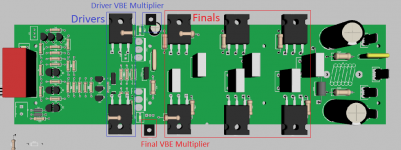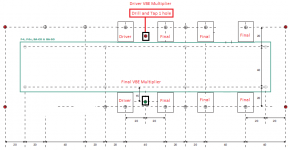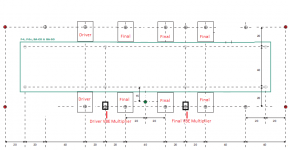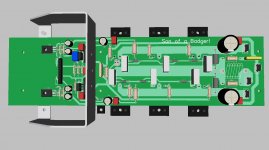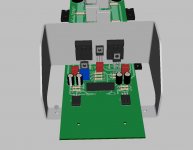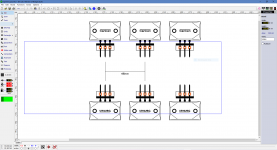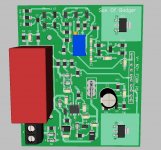However since the audio signal is asymmetrical, not a sine wave, the power demand on one wire could be more than the other (using positive and negative rails).
Can the transient demand in one wire cause induced “interference” into the other wire or am I looking at it in the wrong way?
The output transistors separate the output current into half sines. When you bring the +- supply wires back together, the currents share the same path again, just in separate conductors in the twisted triple. So the half sines recombine in the magnetic field so there are no longer half sine harmonics coupling into other traces on the board.
Is the plan to use the UMS Heatsink drill pattern for mounting pcb/transistors in the diyAudio store?
One could swap boards between the two designs on the same heatsink quickly without having to re-drill/re-tap a bunch of holes.
I'm trying to fit it into the UMS pattern.
I'm very curious about the quality of various BC5xx from the remaining manufacturers. I'm hesitant to trust them because I know that quasi-saturation and Early voltage and base resistance can be totally different between manufacturers. Maybe someone can test them with a DCA Pro.
Those are legacy Fairchild transistors practically, now sell as Onsemi. I have good experience with them.
Sajti
I don't have all of the right 3D models loaded yet. The Slewmaster style layout still needs the servo, servo regulators and the cap multipliers placed. It might fit but it'll be ugly! The screw holes limit the board to around 2 3/4" wide so it's pretty slim.
The screw hole locations aren't playing out well in the Badger version. If we want to screw off the driver heat sink they need to be in the middle of the board killing a lot of space.
Now that you have some final designs published I'll dig a little deeper and see what I can come up with.
This might help with layout but it would definitely eliminate the need to manufacture a custom heatsink for the driver transistors.
Attachments
Vbe's could be to-92's these IPS's use not much more than an op -amp.
You could even put the Vbe's on the IPS PCB.
These circuits could be made to fit in a couple CM squared.
OS
You could even put the Vbe's on the IPS PCB.
These circuits could be made to fit in a couple CM squared.
OS
I've got the preliminary output stage layout done. I opted for a small plug-in input board and added some over-current sensing connections. I'm going to do a SMT input stage first, then see if I can squeeze in a through hole version
Attachments
I've got the preliminary output stage layout done. I opted for a small plug-in input board and added some over-current sensing connections. I'm going to do a SMT input stage first, then see if I can squeeze in a through hole version
NS spirit

I might do a 5 pair layout in the UMS configuration just to see what it looks like. I'm not sure if the UMS pre-drilled heat-sinks are up to the task though. The placement isn't optimal for two row cooling.
Layout looks nice. I definitely like the plug-in front end board.
I would think a three pair output stage would be more than adequate for almost every builder.
I would think a three pair output stage would be more than adequate for almost every builder.
I would think a three pair output stage would be more than adequate for almost every builder.
Says the guy with the 7 output pair amps!😀 Thanks Evan
Layout looks nice. I definitely like the plug-in front end board.
I would think a three pair output stage would be more than adequate for almost every builder.
Yes , I just (almost) got the go-ahead to make the Slewmaster DIYA store
amp.
Single row like the store UMS is better themally. When I had a slew , I noticed
my bottom row was cooler and bias was several mV offset on either P/N rows.
This might not affect the amp in normal operation. At the limit , one row or the
other could hit SOA first.
I'm into speakers now. Most sub - 500$ OEM pairs would really be pushed to the limits by a 6 device OPS. The amp would laugh at most of them.
So , the two row OPS issue most likely be of no concern.😴
OS
- Home
- Amplifiers
- Solid State
- Slewmaster - CFA vs. VFA "Rumble"
